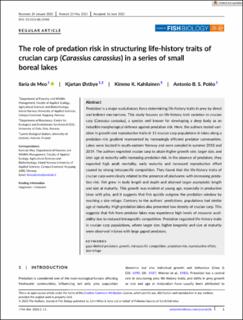| dc.contributor.author | de Meo, Ilaria | |
| dc.contributor.author | Østbye, Kjartan | |
| dc.contributor.author | Kahilainen, Kimmo Kalevi | |
| dc.contributor.author | Poleo, Antonio | |
| dc.coverage.spatial | Norway | en_US |
| dc.date.accessioned | 2023-10-04T07:47:11Z | |
| dc.date.available | 2023-10-04T07:47:11Z | |
| dc.date.created | 2023-09-05T12:19:35Z | |
| dc.date.issued | 2023 | |
| dc.identifier.citation | Journal of Fish Biology. 2023, . | en_US |
| dc.identifier.issn | 0022-1112 | |
| dc.identifier.uri | https://hdl.handle.net/11250/3094011 | |
| dc.description.abstract | Predation is a major evolutionary force determining life-history traits in prey by directand indirect mechanisms. This study focuses on life-history trait variation in cruciancarp (Carassius carassius), a species well known for developing a deep body as aninducible morphological defence against predation risk. Here, the authors tested vari-ation in growth and reproductive traits in 15 crucian carp populations in lakes along apredation risk gradient represented by increasingly efficient predator communities.Lakes were located in south-eastern Norway and were sampled in summer 2018 and2019. The authors expected crucian carp to attain higher growth rate, larger size, andlater age at maturity with increasing predation risk. In the absence of predators, theyexpected high adult mortality, early maturity and increased reproductive effortcaused by strong intraspecific competition. They found that the life-history traits ofcrucian carp were clearly related to the presence of piscivores: with increasing preda-tion risk, fish grew in body length and depth and attained larger asymptotic lengthand size at maturity. This growth was evident at young age, especially in productivelakes with pike, and it suggests that fish quickly outgrew the predation window byreaching a size refuge. Contrary to the authors’predictions, populations had similarage at maturity. High-predation lakes also presented low density of crucian carp. Thissuggests that fish from predator lakes may experience high levels of resource avail-ability due to reduced intraspecific competition. Predation regulated life-history traitsin crucian carp populations, where larger size, higher longevity and size at maturitywere observed in lakes with large gaped predators. | en_US |
| dc.language.iso | eng | en_US |
| dc.rights | Navngivelse 4.0 Internasjonal | * |
| dc.rights.uri | http://creativecommons.org/licenses/by/4.0/deed.no | * |
| dc.subject | gape-limited predators | en_US |
| dc.subject | growth | en_US |
| dc.subject | intraspecific competition | en_US |
| dc.subject | predation risk | en_US |
| dc.subject | reproductive effort | en_US |
| dc.subject | size refuge | en_US |
| dc.title | The role of predation risk in structuring life-history traits of crucian carp (Carassius carassius) in a series of small boreal lakes | en_US |
| dc.type | Peer reviewed | en_US |
| dc.type | Journal article | en_US |
| dc.description.version | publishedVersion | en_US |
| dc.rights.holder | © 2023 The Authors | en_US |
| dc.subject.nsi | VDP::Landbruks- og Fiskerifag: 900::Fiskerifag: 920 | en_US |
| dc.source.pagenumber | 11 | en_US |
| dc.source.journal | Journal of Fish Biology | en_US |
| dc.identifier.doi | 10.1111/jfb.15485 | |
| dc.identifier.cristin | 2172492 | |
| cristin.ispublished | true | |
| cristin.fulltext | original | |
| cristin.qualitycode | 1 | |

